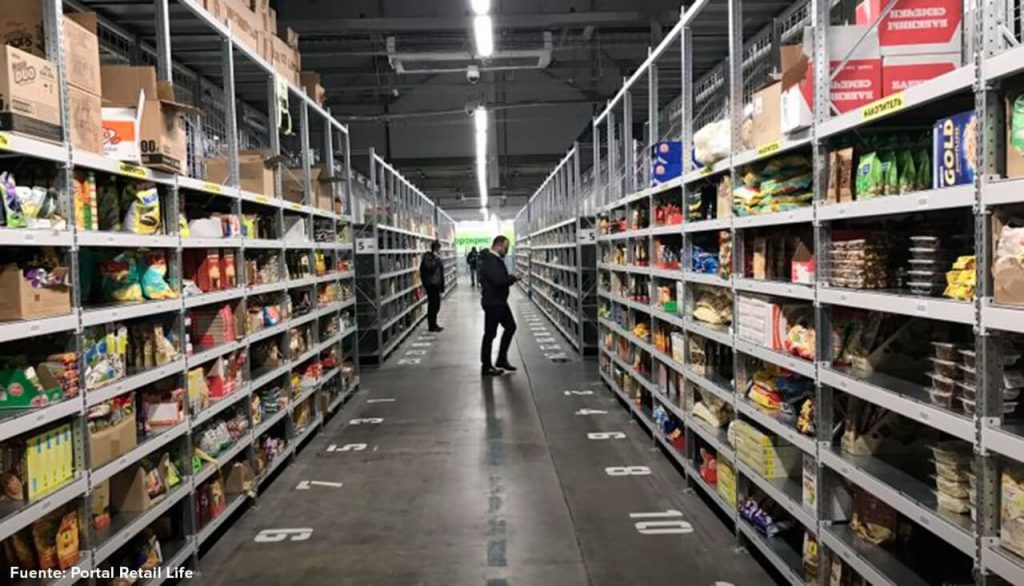Dark Store Management And Retail Store Decommissioning

Introduction to Dark Stores and their Role in Retail Step into the shadowy retail efficiency and optimization world with Dark Store Management. Imagine a retail space shrouded in mystery, where inventory magic happens behind closed doors. Dark Stores are revolutionizing how businesses handle their operations, offering a strategic approach to streamlining processes and boosting productivity. Let’s uncover the secrets and strategies for maximizing inventory and efficiency in these unique retail environments. What is a Dark Store? A Dark Store, also known as a ghost store or virtual store, is a retail space that operates exclusively to fulfill online orders. Unlike traditional brick-and-mortar stores, Dark Stores do not have a physical storefront or display area for customers to browse and purchase products. Instead, they function as fulfillment centers where employees pick and pack items for online orders. History of Dark Stores Dark Stores have been around for over a decade, initially emerging in the grocery industry to fulfill online orders and offer home delivery services. However, their popularity has grown in recent years with the rise of e-commerce and the need for efficient order fulfillment processes. The concept of Dark Stores has also evolved beyond groceries. Retailers in various industries, such as clothing, electronics, and home goods, utilize them to fulfill online orders. Some businesses have even transformed their traditional retail stores into Dark Stores to enhance their e-commerce capabilities. Benefits of Dark Store Management Increased Efficiency: With a dedicated space solely focused on fulfilling online orders, Dark Stores can operate more efficiently than traditional retail stores with both physical storefronts and backroom spaces. Faster Order Fulfillment: By storing inventory in a centralized location, employees can quickly pick and pack items for online orders without navigating through a store or interacting with customers. Cost Savings: Dark Stores can help retailers save on costs associated with maintaining a physical storefront, such as rent, utilities, and staffing for customer service. Flexibility: Since Dark Stores do not have to adhere to traditional store hours or cater to walk-in customers, they Dark Stores are typically located in urban areas with high population density, allowing for faster delivery times to customers. They can be standalone facilities or repurposed retail spaces previously used as traditional stores. Dark Stores originated from the grocery industry in the early 2000s but expanded to other retail sectors such as fashion, electronics, and home goods. Why are Dark Stores used? The rise of e-commerce has significantly changed consumer shopping habits, with more people shopping online rather than in-store. This has led retailers to adapt their operations to meet the growing demand for faster and more efficient delivery options. Dark Stores offer numerous benefits that make them an attractive option for retailers: The Advantages of Dark Store Management Dark Store Management offers numerous advantages for retailers looking to streamline their operations and meet the growing demands of online shoppers. One key advantage is the ability to separate fulfillment from customer-facing activities, allowing for a more efficient picking and packing process without disruptions from in-store foot traffic. By dedicating these dark stores solely to order fulfillment, retailers can optimize inventory management by strategically storing products based on demand patterns, leading to faster order processing and reduced out-of-stock situations. Another advantage lies in the potential cost savings associated with operating dark stores compared to traditional brick-and-mortar locations. Retailers can achieve greater operational efficiency with lower overhead costs related to store maintenance, utilities, and staffing needs focused solely on fulfilling orders rather than servicing customers directly. Additionally, dark store management enables retailers to leverage data analytics and automation technology effectively… Another strategy to optimize inventory is through data analysis. By analyzing sales trends and customer demand patterns, you can accurately forecast future needs. This proactive approach helps stock the right products at the right time, minimizing wastage, and maximizing sales potential. Furthermore, dark store management allows for greater flexibility in meeting the demands of peak shopping periods, such as holidays or sales events. With dedicated fulfillment centers, retailers can ramp up their operations and scale quickly without disrupting in-store operations. Dark Store Management Dark stores also offer a more controlled and secure environment for inventory management. With limited access and fewer people handling products, theft or product damage is less likely. Moreover, dark store management can help retailers improve delivery times and customer satisfaction. By streamlining fulfillment processes and reducing transit times from warehouse to customer, orders can be delivered faster and more efficiently. Finally, dark store management frees up space in traditional retail locations, allowing for potential expansion opportunities. Without costly renovations or relocation. In summary, dark store management offers numerous advantages for retailers looking to optimize. Their inventory management and meet the changing demands of online shoppers. By dedicating these spaces solely to order fulfillment and leveraging data analytics and automation technology, retailers can achieve greater operational efficiency, cost savings, and improved customer satisfaction. Furthermore, implementing efficient replenishment processes based on data insights can help maintain optimal inventory levels. Setting reorder points and safety stock thresholds ensures that popular items are always available while preventing excess stock from sitting idle. This can lead to cost savings by minimizing overstocking and reducing the risk of stockouts. Regularly conducting physical audits and cycle counts can also aid in keeping track of inventory accuracy. By addressing discrepancies promptly, you avoid costly mistakes and maintain an efficient supply chain operation within your dark store environment. Maximizing Efficiency through Proper Staffing and Training By implementing these strategies for optimizing inventory and maximizing efficiency through proper staffing and training. Dark store management can significantly enhance operations and drive profitability. With a well-organized inventory system, streamlined processes, and a trained team of staff members, dark stores can operate at peak performance levels. Utilize Inventory Management Software: Implementing inventory management software can help dark stores keep track of their stock levels, sales data, and order history. This allows for accurate forecasting and planning, reducing the risk of overstocking or stockouts. With real-time data, dark store managers can make informed restocking and
What Is Dark Store Management And How Does It Work?

Step into the shadows of retail management and discover the world of Dark Store Management. As e-commerce reshapes the retail landscape, traditional stores adapt to meet changing consumer demands. Join us through Dark Store Management to uncover its inner workings, benefits, challenges, and solutions. Let’s shine a light on this innovative approach to revolutionizing how retailers operate in the digital age. The Rise of E-commerce and Its Impact on Retail Stores With the rise of e-commerce in recent years, traditional retail stores have faced significant challenges. The convenience of online shopping has transformed consumer behavior, leading to a shift in how people make purchases. E-commerce giants like Amazon have set new standards for fast delivery and personalized shopping experiences, forcing brick-and-mortar retailers to adapt. Retail stores are now reevaluating strategies to stay competitive in this digital age. Many businesses are exploring innovative solutions, such as dark store management, to streamline operations and efficiently meet the demands of online shoppers. Retailers can improve order accuracy and speed up deliveries by optimizing inventory storage and fulfillment processes. As e-commerce grows, its impact on retail stores will only intensify. Traditional retailers who want to thrive in an increasingly digital marketplace will need to adapt to changing consumer preferences and embrace technology-driven solutions. Benefits of Dark Store Management for Retailers Dark Store Management offers numerous benefits to retailers looking to stay competitive in the ever-evolving retail landscape. Fulfill Online Orders One key advantage is the ability to fulfill online orders more efficiently, leading to improved customer satisfaction and retention rates. By utilizing dark stores, retailers can streamline their operations and reduce delivery times, which is crucial in meeting the growing demands of online shoppers. Optimize Inventory Levels Additionally, dark store management allows retailers to optimize their inventory levels and product placement within these fulfillment centers. This strategic approach helps minimize stockouts while maximizing sales opportunities by ensuring popular items are readily available for quick shipment. Real-time Data Analytics Moreover, it allows retailers to adapt quickly to changing market trends and consumer preferences. They can soon reconfigure their fulfillment processes based on real-time data analytics, ultimately improving decision-making and driving profitability. Embracing dark store management empowers retailers to enhance operational efficiency, boost customer satisfaction, and thrive in today’s digital retail environment. How Does Dark Store Management Work? Dark Store Management transforms traditional retail stores into fulfillment centers catering exclusively to online orders. Essentially, these dark stores operate without any customers walking in for shopping. Instead, they are optimized for efficient order picking, packing, and shipping processes. Retailers need sophisticated inventory management systems and automation technologies to make Dark Store Management work seamlessly. Orders are received online and then routed to the nearest dark store based on inventory availability and delivery requirements. Staff at the dark store fulfill orders quickly to meet customer expectations of fast shipping times. By streamlining operations, retailers can improve order accuracy, reduce delivery times, and enhance customer satisfaction. The focus shifts from providing a physical shopping experience to delivering exceptional service through timely order fulfillment. This shift is essential in the evolving e-commerce landscape, where speed and efficiency are critical competitive advantages for retailers looking to succeed in the digital marketplace. Challenges and Solutions for Effective Dark Store Management Managing a dark store comes with its own set of challenges. One common issue is inventory management – ensuring the right products are in stock and readily available for online orders can be tricky. Another challenge is optimizing picking and packing processes to fulfill orders efficiently. Communication between different teams within the dark store can sometimes be a hurdle, leading to delays and errors in order fulfillment. Moreover, maintaining consistent quality control standards can be challenging when dealing with high volumes of orders. Implementing advanced technology, such as automated picking systems and inventory management software, can streamline operations and tackle these challenges. Effectively training staff on proper procedures and protocols is also crucial for smooth functioning. Regularly analyzing data and customer feedback helps identify areas for improvement in management practices. Adapting quickly to changing market demands is essential for staying competitive in the e-commerce landscape. Post-Pandemic Dark Store Investments Post-Pandemic Dark Store Investments have become increasingly popular in retail real estate. As the retail landscape continues to evolve post-pandemic, more and more investors are looking to capitalize on the growing trend of dark stores. These vacant or underutilized spaces offer a prime opportunity for redevelopment into distribution centers, fulfillment centers, or last-mile delivery hubs, catering to the increasing demand for e-commerce logistics. With consumers shifting towards online shopping even more rapidly due to COVID-19, these investments present promising returns for those willing to adapt and innovate in this new era of retail. By repurposing these empty spaces into efficient and strategically located facilities, businesses can better meet their customers’ demands while reducing operational costs and improving sustainability efforts. Post-Pandemic Dark Store Investments are not just about transforming physical space but also about reimagining traditional retail concepts for a digital-first world. Conclusion Dark store management is a crucial strategy for retailers to stay competitive in the ever-evolving e-commerce landscape. By transforming traditional retail spaces into fulfillment centers, businesses can meet the growing demand for online shopping while optimizing their operations. From streamlining order processing and increasing efficiency to providing faster delivery times and enhancing customer satisfaction, dark store management offers a range of benefits that can drive growth and success for retailers. However, it also comes with challenges that require innovative solutions. By leveraging technology, implementing efficient processes, and prioritizing customer experience, retailers can effectively manage their dark stores and capitalize on e-commerce opportunities. As consumer preferences shift towards online shopping, mastering dark store management will be essential for staying ahead in the retail industry.






